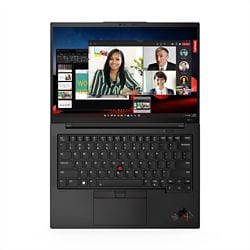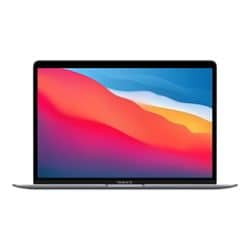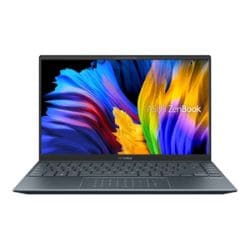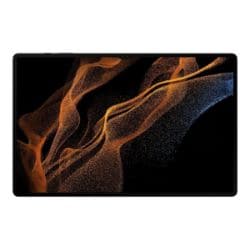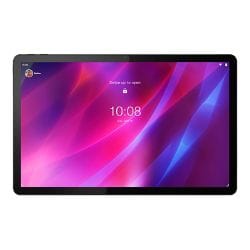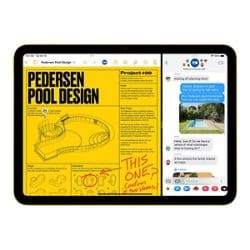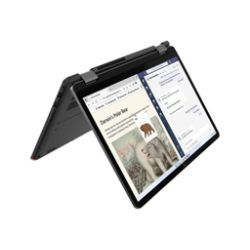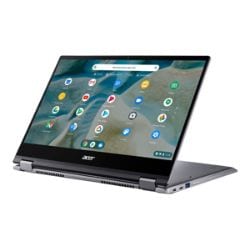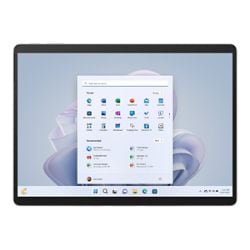March 04, 2020
Laptop vs. Tablet vs. 2-in-1s: Pros and Cons
Considering a new computer, but can't decide if a tablet or laptop is the better choice? Learn the pros and cons of each and see how 2-in-1 laptops compare.
Tablet vs. Laptop: Which is Better?
Are you considering a new computer, but can't decide if a tablet or laptop is the better choice? Learn the pros and cons of each—and also find out how 2-in-1 laptops compare.
Your old computer has given up the ghost and gone to that big PC graveyard in the sky. Now it is time for some tough decisions. Technology changes rapidly, and there are so many more options for computer use compared to just a few years ago.
If you enjoy sitting on the couch, outside or at a coffee shop as you work or play on the computer, there are two main transportable options that you are probably considering: laptops and tablets. But which one is the right choice for you?
The Difference Between a Tablet and a Laptop
With more flexibility and portability than desktops, laptops feature a traditional keyboard on the bottom and screen on top. They fold closed for easy travel. Most form factors feature a traditional operating system, such as Windows or iOS, along with endless configurations of inputs, outputs, DVD drives, memory, storage space, processor speeds and more.
Tablets, on the other hand, are even more portable than laptops. Compact and lightweight, they fit into backpacks, briefcases and even handbags. Though they don't come equipped with a traditional keyboard, they're built with HD displays and responsive, interactive touchscreens. Tablets can also support and power a wide range of applications, letting you work or play from anywhere.
Pros and Cons of a Laptop
Consider the pros and cons of a laptop — the personal computer that you can tote around.
Pros
Performance: Laptops, otherwise known as notebook computers, include higher-performing processors because they are large enough to feature internal fans, which effectively cools the processors. As a result, laptops have more power than tablets and can easily run multiple programs simultaneously. This makes laptops particularly efficient and conducive to hardcore multitasking.
Storage: Because laptops use traditional hard drives, they have greater storage capacity relative to tablets. Most laptops today can have as much as 1 Terabyte (TB) or 1000 Gigabytes (GB) in hard drive capacity, which means you’ll have plenty of room for all your files, images and videos. Although the latest innovations in tablet technology make it possible to expand storage capabilities, it is more difficult and less seamless than doing so on a laptop. It is a simple process to connect laptops to external hard drives in order to store additional content.
Input Methods: An attached physical keyboard provides an easy, ergonomic typing experience. Without question, laptops offer a more convenient typing experience and are more useful for putting together longer documents or presentation decks with a high quantity of text. The trackpads on laptops also enable easier navigation in some cases relative to the touchscreen experience. And when trackpad navigation just won’t cut it, it’s a cinch to use a wireless Bluetooth mouse with your laptop.
Software and Compatability: Equipped with full desktop architecture, laptops can support a wider range of programs, from media software suites to mobile web apps and more.
Cons
Portability: Due to their thicker superstructures and heavier batteries, laptops weigh more than tablets. Most laptops weigh at least three pounds. Laptop screens are also considerably larger than most tablet screens, generally between 12-17 inches. Because of their weight and screen size, laptops can be more difficult to transport and may require the use of larger work bags or backpacks to fit them.
Price Range: Laptops are more expensive because of their higher quality hardware. While some lower-priced, basic laptops are now emerging in the market, laptops with the best functionality and most versatility will set you back considerably. Some of the highest quality laptops can be as much as $3000 or more. Because of this, some might consider a laptop a higher involvement purchase than a tablet.
Malware: Laptops can be vulnerable to viruses and malware attacks. Viruses are designed specifically to attack computers, so laptops are more at risk than tablets. If you purchase a laptop, you may want to consider purchasing anti-viral software to help protect your files and information.
What Can a Laptop Do that a Tablet Can't?
Laptops are built to be versatile, multitasking machines. If you need to handle a wide range of work, or keep multiple tabs open over the course of the day, you might want to consider investing in a laptop.
Pros and Cons of a Tablet
Consider the pros and cons of a tablet — a portable, handheld touchscreen device.
Pros
Portability: Sleek and lightweight, tablet PCs are extremely portable and can fit in purses and even pockets. Some tablets weigh less than a pound. This makes them an ideal choice for frequent travelers.
Battery Life: Because of their smaller screen sizes and less hardware, tablets have longer battery life. Tablets can also have more reliable batteries. Some tablet models boast battery life for up to 14 hours.
Price Range: Tablets are less expensive than laptops as they have fewer features. It’s possible to find a functional tablet for less than $200. More cutting-edge tablets can also still be quite affordable for a variety of different budgets, and offer more functionality than the more basic models.
Cons
Storage: Tablets use SSDs (solid-state drives) for storage. This makes most tablets less bulky but also means they have less storage capacity. Tablets can be connected to external hard drives, but it's usually more complicated to expand the storage capability of this kind of device relative to laptops.
Software and Compatibility: Mobile apps and touch-optimized software mean that for full functionality, a developer has to make an app for your mobile operating system.
Input Methods: Tablets only have touchscreen keyboards, which is incredibly convenient when it comes to browsing. However, if you're planning on doing a large amount of typing on your tablet, you'll need to invest in an external keyboard with Bluetooth connectivity. An external keyboard is usually not quite as comfortable or functional as a built-in keyboard on a laptop, and it can be cumbersome to attach the keyboard to the tablet. Additonal device connectivity will require hubs and dongles to make your tablet as fully functional as a laptop.
Can a Tablet Replace a Laptop?
Tablets are a fantastic choice when it comes to media consumption and casual use. If you want a device that lets you connect with other people, or just relax all by yourself, you might want to consider looking into a tablet.
Pros and Cons of a 2-in-1 Laptop
Explore the benefits and disadvantages of a 2-in-1 PC—the device that combines features of a traditional laptop and tablet.
Pros
Input Methods: While traditional tablets lack the ergonomic typing experience that a full keyboard offers, a 2-in-1 PC offers full typing capability. As a result, you don’t have to sacrifice the ability to comfortably type long documents on your device. There’s also no need carry around a clunky external keyboard, as it’s built into the computer or easy to seamlessly attach. Because 2-in-1 laptops feature both trackpad and touchscreen capabilities, users have multiple ways to control the navigational experience. This offers ultimate flexibility when using your device. If you’re scrolling through complex software programs, you can use a full trackpad. On the other hand, when you want to just put on your favorite Netflix show and relax, the touchscreen makes that a cinch.
Performance: Much like traditional laptops, 2-in-1 laptops often feature powerful processors that enable multitasking and efficient use of multiple programs at the same time. Therefore, you won’t need to compromise on productivity with a 2-in-1 or worry about overloading the device with too many open apps; you can toggle between all your favorite apps worry-free.
Cons
Price Range: It’s important to note that all the functionality of a 2-in-1 laptop comes at a price. 2-in-1 devices tend to cost as much as higher-end laptops, which means that tablets are still the more affordable option. 2-in-1 devices are usually a substantial investment, and the leading models aren’t necessarily easy on the wallet.
Software and Compatibility: Right now, 2-in-1 laptops only run on either Windows or Chrome operating systems. Therefore, if you’re an avid iOS or Android fan, you won’t have those options available with a hybrid device. There are also fewer choices in general on the market right now compared to traditional laptops and tablets, which means your 2-in-1 options can be limited.
A Computer With a Tablet
Because a 2-in-1 PC might enable you to pare down your devices, you can save money in the long run if you opt not to purchase a separate laptop and tablet. This also means you can ditch that massive work bag or backpack when you’re on-the-go since you’ll have fewer devices to tote around.
Which Should You Choose?
The first consideration when choosing a new laptop or tablet is the main purpose for which the computing device will be used. If you need to do a large amount of typing or work with multiple software applications simultaneously, a laptop is your best bet. If you need a device for internet browsing, keeping up with the news, or kicking back with a movie, a tablet can accomplish that. There is no right or wrong here — pick the device that works for your life.
Work
Will you be using the device as a home workstation? From video conferencing applications, to webcams, to word processing tools, your device will need to handle all the apps effectively and efficiently. The device will also require a long battery life or fast charging capabilities. An ergonomically-friendly design doesn't hurt either. In this instance, you might want to opt for a laptop or 2-in-1.
Field Use/Front Line Work
Because some tablets operate on closed systems, it is unlikely that you’ll catch a virus or malware on the device. As a result, your sensitive information may be more secure on a tablet. It's also a lot easier to move around with a tablet, or to take notes on the go. You can then transfer that information once you're back in the office.
School
While tablets might seem like the natural choice here, it's worth thinking twice before you hit purchase. Tablets are lightweight and can make taking notes easy. However, laptops come built for education and classrooms, and can support online learning programs. Laptops are also often equipped with the software to power learning tools, and provide students with access to those tools at home.
Personal
Will you be using the device for web browsing or watching videos? If you plan on just using the device for pleasure, you might want to consider something completely portable like an iPad or lightweight Android or Windows tablet that can be used both in your home and outside of it. These lighter devices may not be able to run complex games or intensive apps, but they're great to take on-the-go as a larger alternative to a smartphone.
Media
Tablets’ large screens make it easy to consume video content, e-books and other types of media. Because of their large touchscreens, tablets offer a pleasurable viewing experience and are great for catching up on your favorite TV shows, movies, or books while on-the-go. If you will mainly use the device for reading, consider a dedicated e-reader, which sometimes offers other apps or web browsing capabilities.
Content Creation
Laptops can be a powerful solution for creating and publishing content. Laptops are equipped with the processing power to handle creative software suites for video, photos and animation. This also means that laptops have the ability to drive faster photo/video ingestion workflows.

